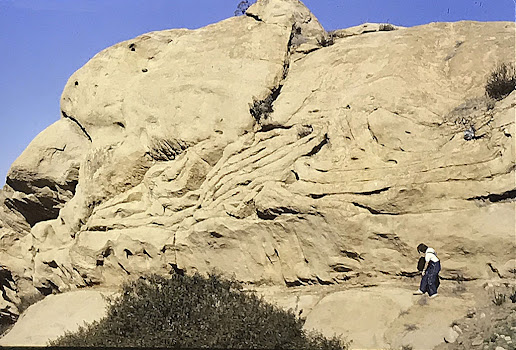This post concerns an “eye-popping” section of extremely slump-folded sandstone beds within the Chatsworth Formation, in the Simi Hills of Ventura County, southern California. You have to see the actual beds, or see a picture of them, in order to believe it.
These slump-folds are of Late Cretaceous age (late Campanian/early Maastrichtian age, about 70 million years old). They are located on protected land.
Three images of these slump beds are shown below (a person provides the scale): the first two are essentially the same view, but the second of these two was taken under different lighting. The third image is of the same channelized flow but a several meters westward, near the lowermost part of the slump feature.
The folded/crumpled beds consist of numerous wedge-outs of sand-rich deposits (with a sandstone to mudstone ratio of 12:1). These beds filled a braided-channel, turbidite deposit in a deep-sea-fan system of a submarine middle-fan environment (see references below for all the gory details). Turbidites are deposits of sediment-gravity flows which include turbidity currents, fluidized sediment flow, grain flow, and debris-flow mechanisms. The beds were originally in a semi-liquid state, unstable, and slid down a slope.
For more details, see the following references:
Link, M.H. 1981. Sand-rich turbidite facies of the Upper Cretaceous Chatsworth Formation, Simi Hills, California. Pp. 63–70, in Link, M.H., R.L. Squires, and I.P. Colburn, (eds). Simi Hills Cretaceous turbidites, southern California. Pacific Section, Society of Economic Paleontology and Mineralogy [Guidebook]. Los Angeles, California. 134 pp.
Note: This slump fold was illustrated also on the cover of AAPG, v. 67, no. 3, 1983.
Link, M.H., I.P. Colburn, and R.L. Squires. 1984. Slope and deep-sea fan facies and paleogeography of Upper Cretaceous Chatsworth Formation, Simi Hills, California. The American Association of Petroleum Geologists, v. 68 (no. 7):850-873, 22 figs., 4 tables. Note: See Fig. 12D for a picture of the slump fold illustrated in this present blog post.



No comments:
Post a Comment